Economic Principles & Decision Making: Australian Economy Analysis
VerifiedAdded on 2023/01/18
|11
|3635
|72
Report
AI Summary
This report provides an in-depth analysis of the current economic situation in Australia, examining the challenges and the strategies employed to address them. It begins by outlining Australia's economic performance, including GDP growth, labor market trends, and interest rates. The report then de...
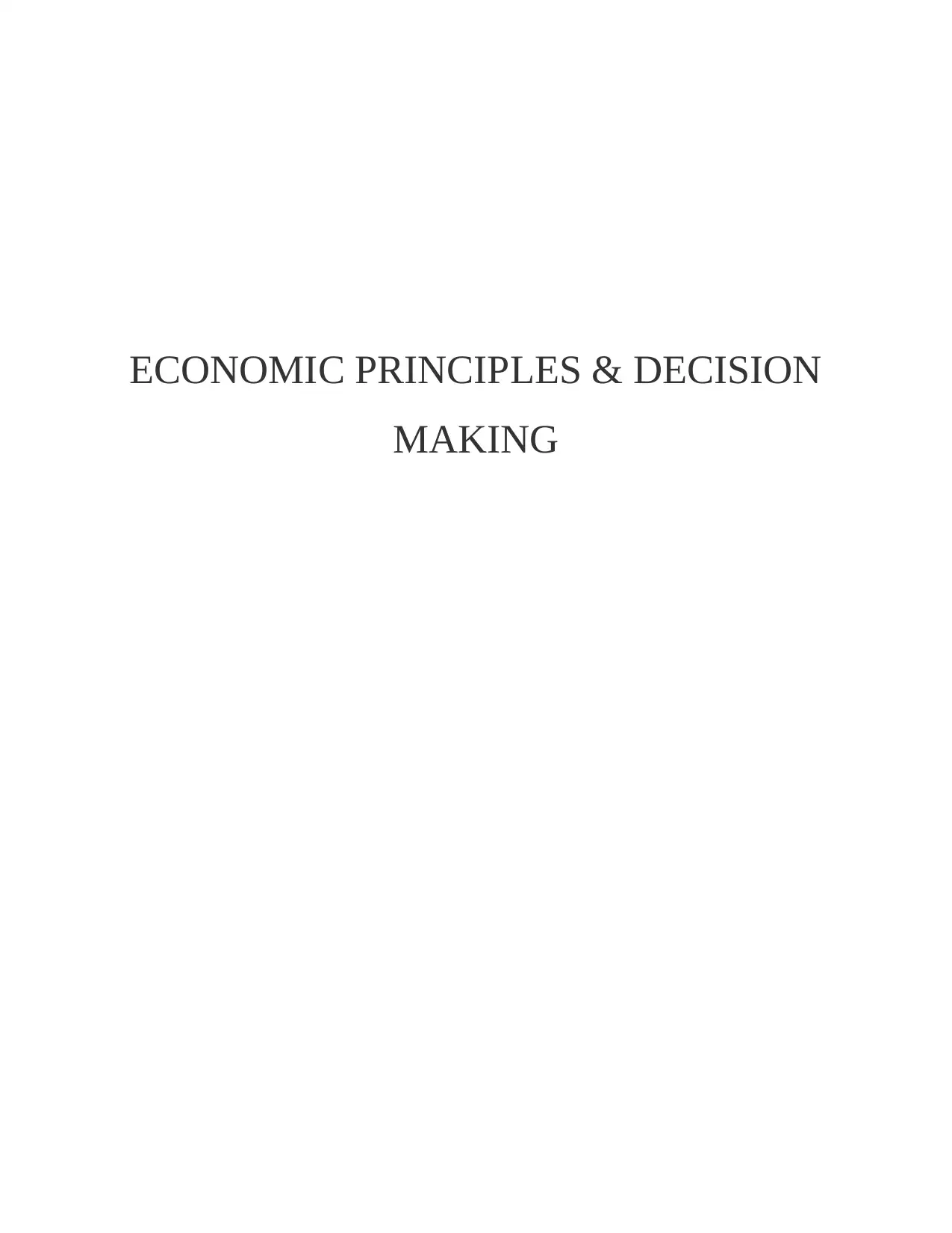
ECONOMIC PRINCIPLES & DECISION
MAKING
MAKING
Paraphrase This Document
Need a fresh take? Get an instant paraphrase of this document with our AI Paraphraser
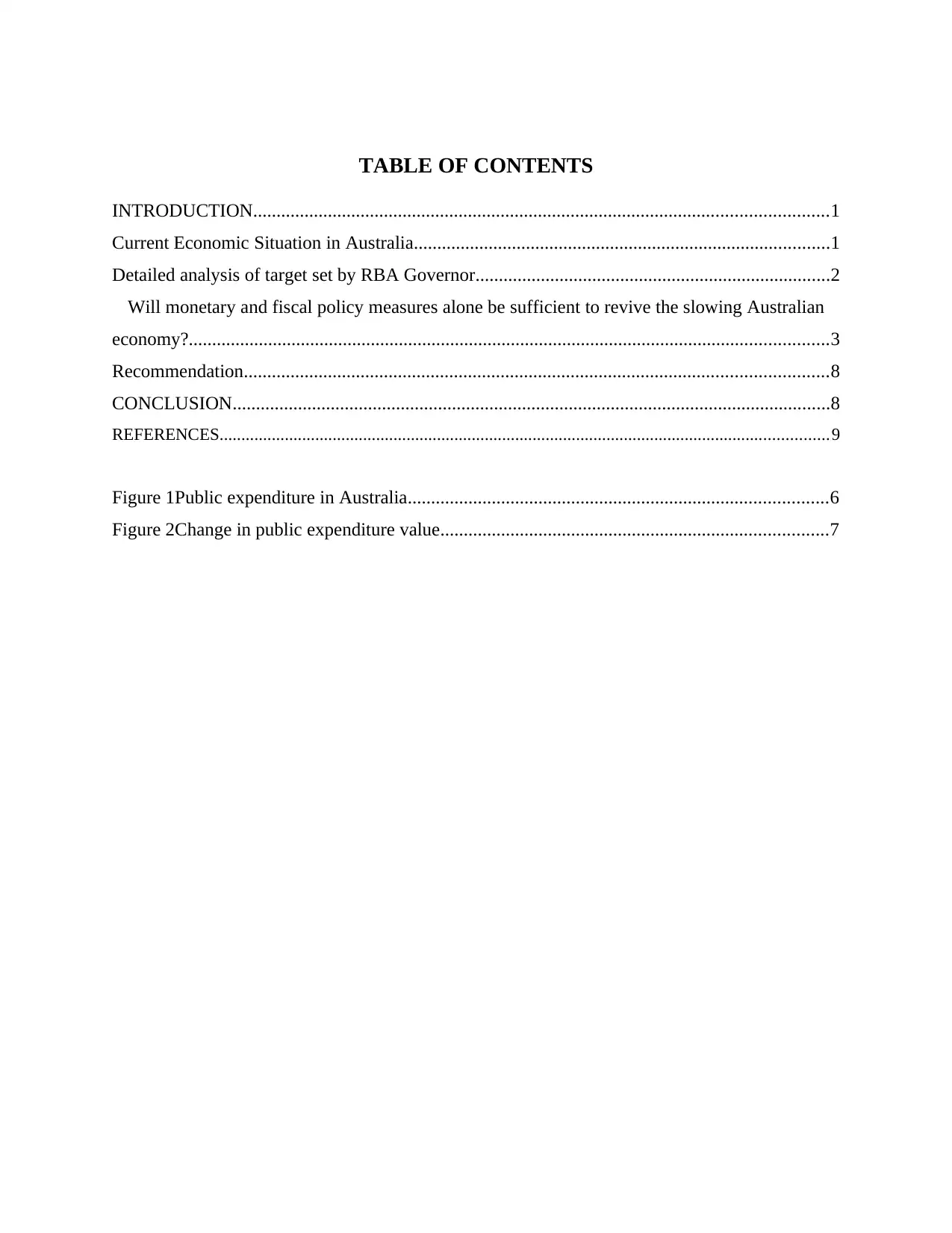
TABLE OF CONTENTS
INTRODUCTION...........................................................................................................................1
Current Economic Situation in Australia.........................................................................................1
Detailed analysis of target set by RBA Governor............................................................................2
Will monetary and fiscal policy measures alone be sufficient to revive the slowing Australian
economy?.........................................................................................................................................3
Recommendation.............................................................................................................................8
CONCLUSION................................................................................................................................8
REFERENCES............................................................................................................................................9
Figure 1Public expenditure in Australia..........................................................................................6
Figure 2Change in public expenditure value...................................................................................7
INTRODUCTION...........................................................................................................................1
Current Economic Situation in Australia.........................................................................................1
Detailed analysis of target set by RBA Governor............................................................................2
Will monetary and fiscal policy measures alone be sufficient to revive the slowing Australian
economy?.........................................................................................................................................3
Recommendation.............................................................................................................................8
CONCLUSION................................................................................................................................8
REFERENCES............................................................................................................................................9
Figure 1Public expenditure in Australia..........................................................................................6
Figure 2Change in public expenditure value...................................................................................7
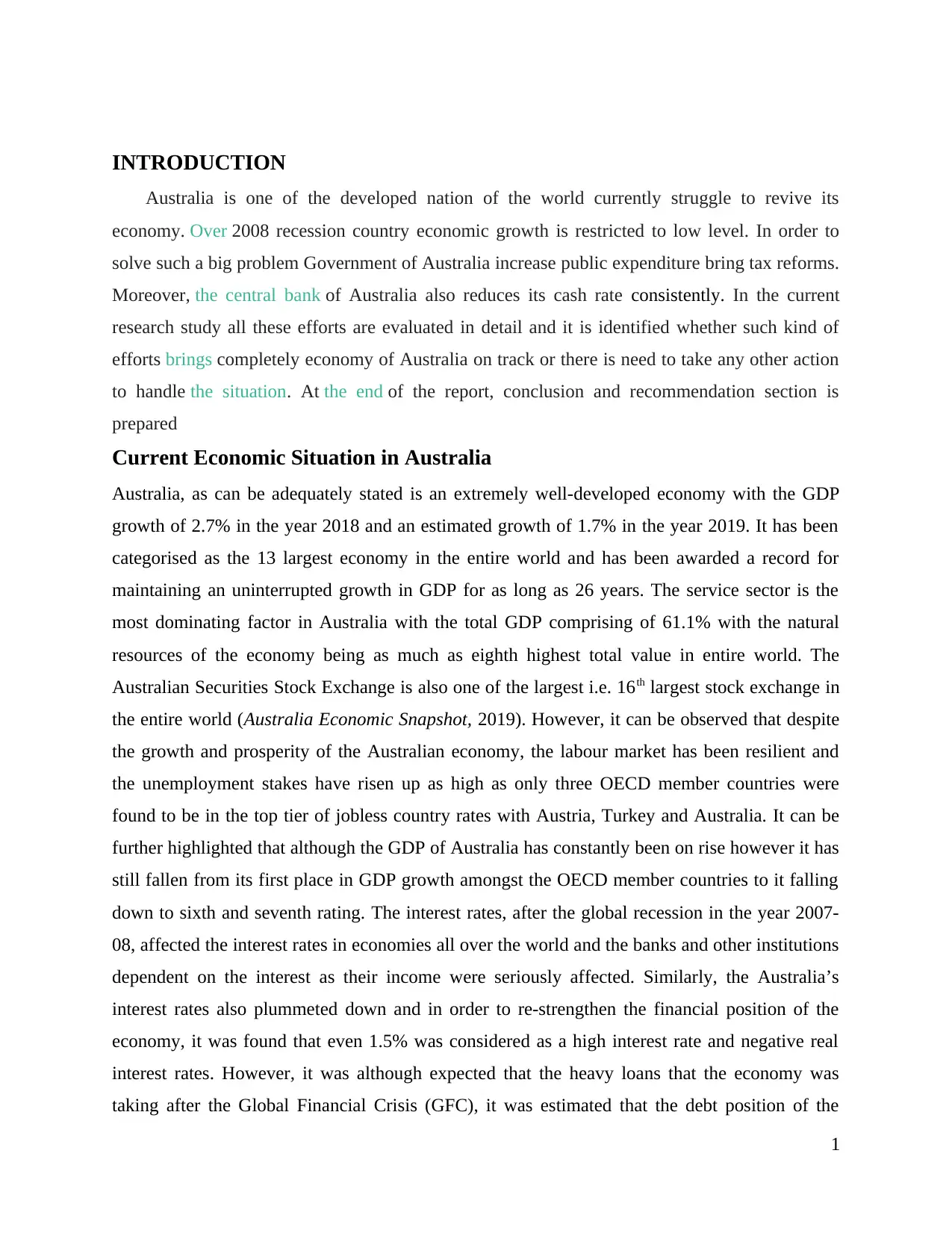
INTRODUCTION
Australia is one of the developed nation of the world currently struggle to revive its
economy. Over 2008 recession country economic growth is restricted to low level. In order to
solve such a big problem Government of Australia increase public expenditure bring tax reforms.
Moreover, the central bank of Australia also reduces its cash rate consistently. In the current
research study all these efforts are evaluated in detail and it is identified whether such kind of
efforts brings completely economy of Australia on track or there is need to take any other action
to handle the situation. At the end of the report, conclusion and recommendation section is
prepared
Current Economic Situation in Australia
Australia, as can be adequately stated is an extremely well-developed economy with the GDP
growth of 2.7% in the year 2018 and an estimated growth of 1.7% in the year 2019. It has been
categorised as the 13 largest economy in the entire world and has been awarded a record for
maintaining an uninterrupted growth in GDP for as long as 26 years. The service sector is the
most dominating factor in Australia with the total GDP comprising of 61.1% with the natural
resources of the economy being as much as eighth highest total value in entire world. The
Australian Securities Stock Exchange is also one of the largest i.e. 16th largest stock exchange in
the entire world (Australia Economic Snapshot, 2019). However, it can be observed that despite
the growth and prosperity of the Australian economy, the labour market has been resilient and
the unemployment stakes have risen up as high as only three OECD member countries were
found to be in the top tier of jobless country rates with Austria, Turkey and Australia. It can be
further highlighted that although the GDP of Australia has constantly been on rise however it has
still fallen from its first place in GDP growth amongst the OECD member countries to it falling
down to sixth and seventh rating. The interest rates, after the global recession in the year 2007-
08, affected the interest rates in economies all over the world and the banks and other institutions
dependent on the interest as their income were seriously affected. Similarly, the Australia’s
interest rates also plummeted down and in order to re-strengthen the financial position of the
economy, it was found that even 1.5% was considered as a high interest rate and negative real
interest rates. However, it was although expected that the heavy loans that the economy was
taking after the Global Financial Crisis (GFC), it was estimated that the debt position of the
1
Australia is one of the developed nation of the world currently struggle to revive its
economy. Over 2008 recession country economic growth is restricted to low level. In order to
solve such a big problem Government of Australia increase public expenditure bring tax reforms.
Moreover, the central bank of Australia also reduces its cash rate consistently. In the current
research study all these efforts are evaluated in detail and it is identified whether such kind of
efforts brings completely economy of Australia on track or there is need to take any other action
to handle the situation. At the end of the report, conclusion and recommendation section is
prepared
Current Economic Situation in Australia
Australia, as can be adequately stated is an extremely well-developed economy with the GDP
growth of 2.7% in the year 2018 and an estimated growth of 1.7% in the year 2019. It has been
categorised as the 13 largest economy in the entire world and has been awarded a record for
maintaining an uninterrupted growth in GDP for as long as 26 years. The service sector is the
most dominating factor in Australia with the total GDP comprising of 61.1% with the natural
resources of the economy being as much as eighth highest total value in entire world. The
Australian Securities Stock Exchange is also one of the largest i.e. 16th largest stock exchange in
the entire world (Australia Economic Snapshot, 2019). However, it can be observed that despite
the growth and prosperity of the Australian economy, the labour market has been resilient and
the unemployment stakes have risen up as high as only three OECD member countries were
found to be in the top tier of jobless country rates with Austria, Turkey and Australia. It can be
further highlighted that although the GDP of Australia has constantly been on rise however it has
still fallen from its first place in GDP growth amongst the OECD member countries to it falling
down to sixth and seventh rating. The interest rates, after the global recession in the year 2007-
08, affected the interest rates in economies all over the world and the banks and other institutions
dependent on the interest as their income were seriously affected. Similarly, the Australia’s
interest rates also plummeted down and in order to re-strengthen the financial position of the
economy, it was found that even 1.5% was considered as a high interest rate and negative real
interest rates. However, it was although expected that the heavy loans that the economy was
taking after the Global Financial Crisis (GFC), it was estimated that the debt position of the
1
You're viewing a preview
Unlock full access by subscribing today!
Enjoy unlimited downloads | Full document access |
Advanced AI study tools
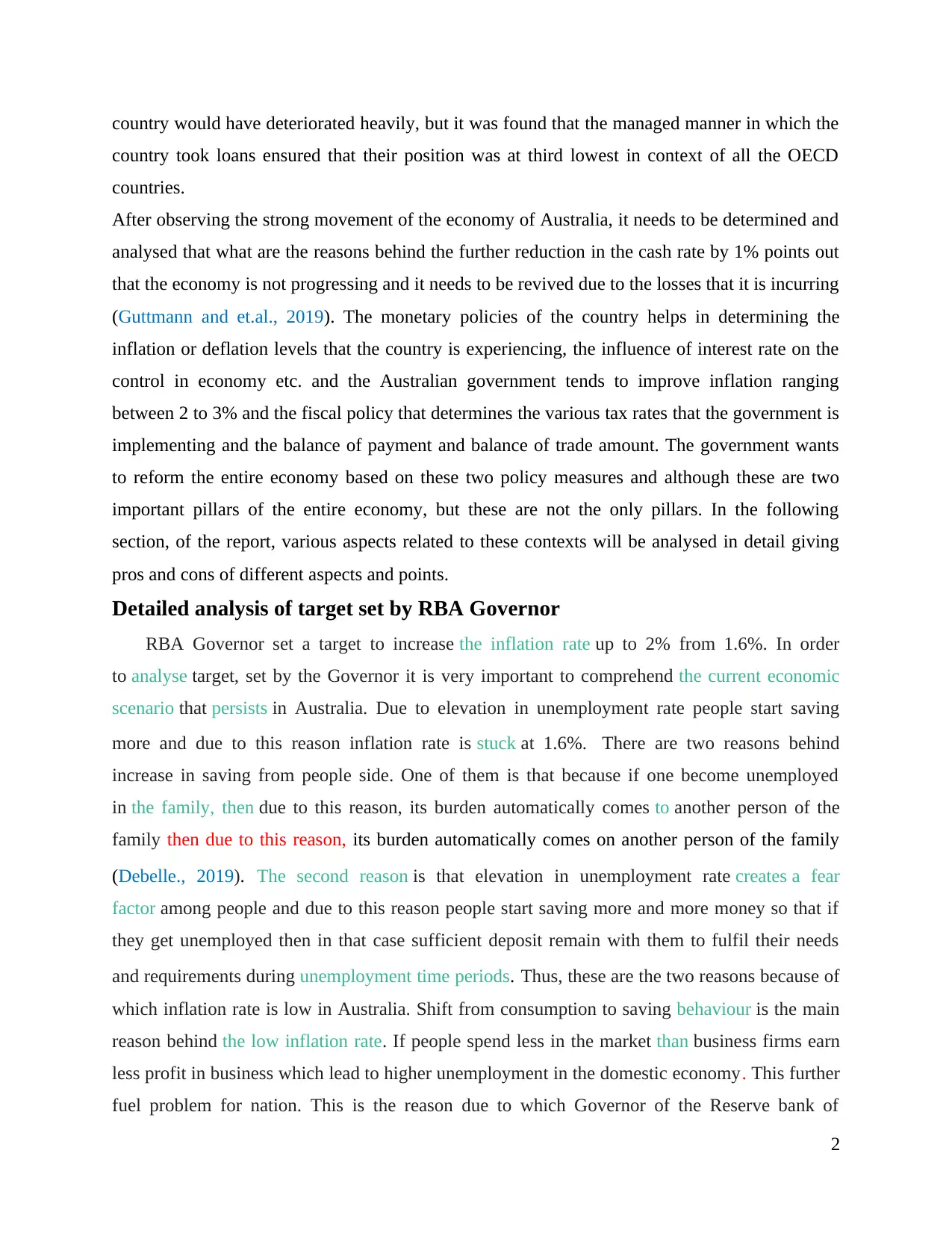
country would have deteriorated heavily, but it was found that the managed manner in which the
country took loans ensured that their position was at third lowest in context of all the OECD
countries.
After observing the strong movement of the economy of Australia, it needs to be determined and
analysed that what are the reasons behind the further reduction in the cash rate by 1% points out
that the economy is not progressing and it needs to be revived due to the losses that it is incurring
(Guttmann and et.al., 2019). The monetary policies of the country helps in determining the
inflation or deflation levels that the country is experiencing, the influence of interest rate on the
control in economy etc. and the Australian government tends to improve inflation ranging
between 2 to 3% and the fiscal policy that determines the various tax rates that the government is
implementing and the balance of payment and balance of trade amount. The government wants
to reform the entire economy based on these two policy measures and although these are two
important pillars of the entire economy, but these are not the only pillars. In the following
section, of the report, various aspects related to these contexts will be analysed in detail giving
pros and cons of different aspects and points.
Detailed analysis of target set by RBA Governor
RBA Governor set a target to increase the inflation rate up to 2% from 1.6%. In order
to analyse target, set by the Governor it is very important to comprehend the current economic
scenario that persists in Australia. Due to elevation in unemployment rate people start saving
more and due to this reason inflation rate is stuck at 1.6%. There are two reasons behind
increase in saving from people side. One of them is that because if one become unemployed
in the family, then due to this reason, its burden automatically comes to another person of the
family then due to this reason, its burden automatically comes on another person of the family
(Debelle., 2019). The second reason is that elevation in unemployment rate creates a fear
factor among people and due to this reason people start saving more and more money so that if
they get unemployed then in that case sufficient deposit remain with them to fulfil their needs
and requirements during unemployment time periods. Thus, these are the two reasons because of
which inflation rate is low in Australia. Shift from consumption to saving behaviour is the main
reason behind the low inflation rate. If people spend less in the market than business firms earn
less profit in business which lead to higher unemployment in the domestic economy. This further
fuel problem for nation. This is the reason due to which Governor of the Reserve bank of
2
country took loans ensured that their position was at third lowest in context of all the OECD
countries.
After observing the strong movement of the economy of Australia, it needs to be determined and
analysed that what are the reasons behind the further reduction in the cash rate by 1% points out
that the economy is not progressing and it needs to be revived due to the losses that it is incurring
(Guttmann and et.al., 2019). The monetary policies of the country helps in determining the
inflation or deflation levels that the country is experiencing, the influence of interest rate on the
control in economy etc. and the Australian government tends to improve inflation ranging
between 2 to 3% and the fiscal policy that determines the various tax rates that the government is
implementing and the balance of payment and balance of trade amount. The government wants
to reform the entire economy based on these two policy measures and although these are two
important pillars of the entire economy, but these are not the only pillars. In the following
section, of the report, various aspects related to these contexts will be analysed in detail giving
pros and cons of different aspects and points.
Detailed analysis of target set by RBA Governor
RBA Governor set a target to increase the inflation rate up to 2% from 1.6%. In order
to analyse target, set by the Governor it is very important to comprehend the current economic
scenario that persists in Australia. Due to elevation in unemployment rate people start saving
more and due to this reason inflation rate is stuck at 1.6%. There are two reasons behind
increase in saving from people side. One of them is that because if one become unemployed
in the family, then due to this reason, its burden automatically comes to another person of the
family then due to this reason, its burden automatically comes on another person of the family
(Debelle., 2019). The second reason is that elevation in unemployment rate creates a fear
factor among people and due to this reason people start saving more and more money so that if
they get unemployed then in that case sufficient deposit remain with them to fulfil their needs
and requirements during unemployment time periods. Thus, these are the two reasons because of
which inflation rate is low in Australia. Shift from consumption to saving behaviour is the main
reason behind the low inflation rate. If people spend less in the market than business firms earn
less profit in business which lead to higher unemployment in the domestic economy. This further
fuel problem for nation. This is the reason due to which Governor of the Reserve bank of
2
Paraphrase This Document
Need a fresh take? Get an instant paraphrase of this document with our AI Paraphraser
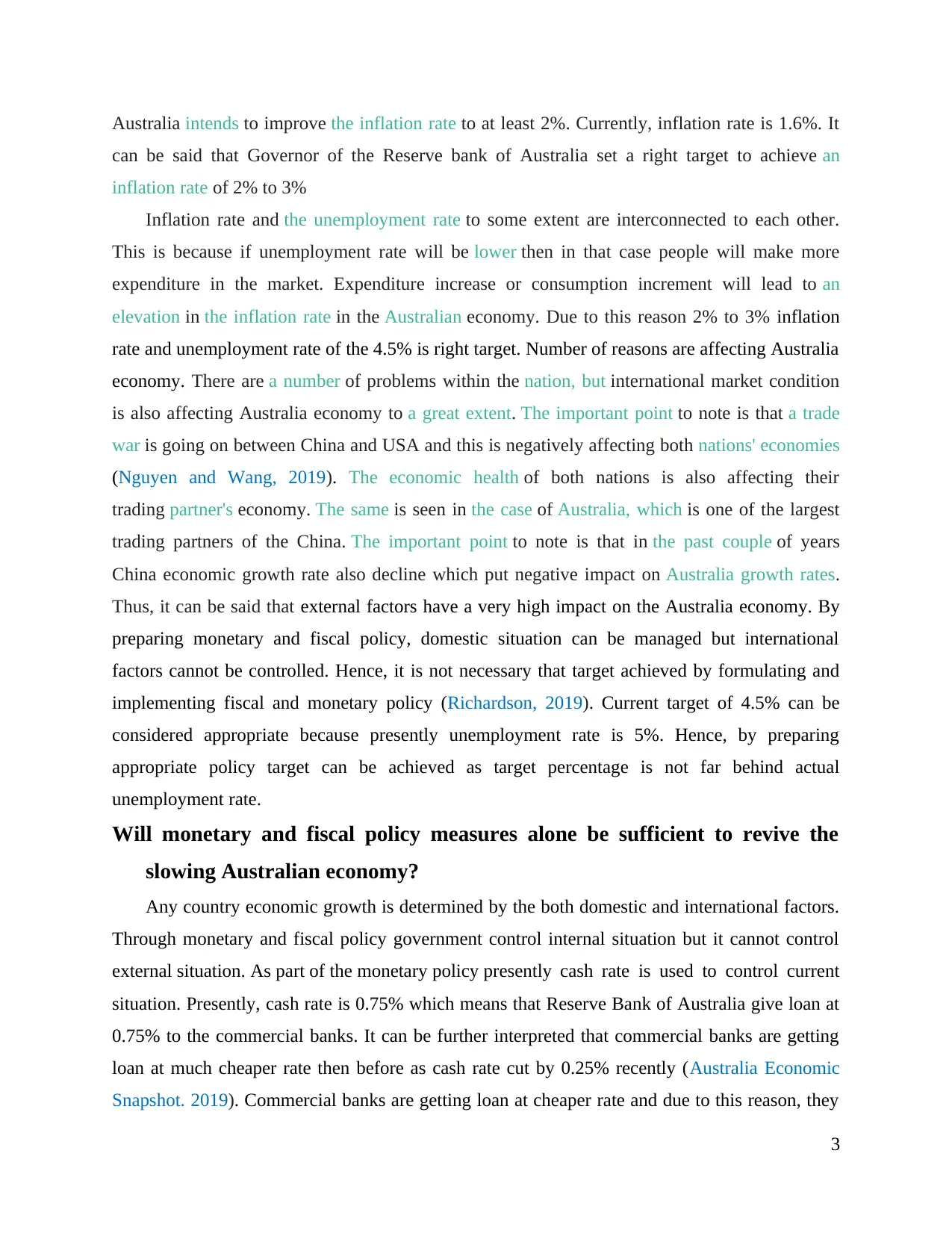
Australia intends to improve the inflation rate to at least 2%. Currently, inflation rate is 1.6%. It
can be said that Governor of the Reserve bank of Australia set a right target to achieve an
inflation rate of 2% to 3%
Inflation rate and the unemployment rate to some extent are interconnected to each other.
This is because if unemployment rate will be lower then in that case people will make more
expenditure in the market. Expenditure increase or consumption increment will lead to an
elevation in the inflation rate in the Australian economy. Due to this reason 2% to 3% inflation
rate and unemployment rate of the 4.5% is right target. Number of reasons are affecting Australia
economy. There are a number of problems within the nation, but international market condition
is also affecting Australia economy to a great extent. The important point to note is that a trade
war is going on between China and USA and this is negatively affecting both nations' economies
(Nguyen and Wang, 2019). The economic health of both nations is also affecting their
trading partner's economy. The same is seen in the case of Australia, which is one of the largest
trading partners of the China. The important point to note is that in the past couple of years
China economic growth rate also decline which put negative impact on Australia growth rates.
Thus, it can be said that external factors have a very high impact on the Australia economy. By
preparing monetary and fiscal policy, domestic situation can be managed but international
factors cannot be controlled. Hence, it is not necessary that target achieved by formulating and
implementing fiscal and monetary policy (Richardson, 2019). Current target of 4.5% can be
considered appropriate because presently unemployment rate is 5%. Hence, by preparing
appropriate policy target can be achieved as target percentage is not far behind actual
unemployment rate.
Will monetary and fiscal policy measures alone be sufficient to revive the
slowing Australian economy?
Any country economic growth is determined by the both domestic and international factors.
Through monetary and fiscal policy government control internal situation but it cannot control
external situation. As part of the monetary policy presently cash rate is used to control current
situation. Presently, cash rate is 0.75% which means that Reserve Bank of Australia give loan at
0.75% to the commercial banks. It can be further interpreted that commercial banks are getting
loan at much cheaper rate then before as cash rate cut by 0.25% recently (Australia Economic
Snapshot. 2019). Commercial banks are getting loan at cheaper rate and due to this reason, they
3
can be said that Governor of the Reserve bank of Australia set a right target to achieve an
inflation rate of 2% to 3%
Inflation rate and the unemployment rate to some extent are interconnected to each other.
This is because if unemployment rate will be lower then in that case people will make more
expenditure in the market. Expenditure increase or consumption increment will lead to an
elevation in the inflation rate in the Australian economy. Due to this reason 2% to 3% inflation
rate and unemployment rate of the 4.5% is right target. Number of reasons are affecting Australia
economy. There are a number of problems within the nation, but international market condition
is also affecting Australia economy to a great extent. The important point to note is that a trade
war is going on between China and USA and this is negatively affecting both nations' economies
(Nguyen and Wang, 2019). The economic health of both nations is also affecting their
trading partner's economy. The same is seen in the case of Australia, which is one of the largest
trading partners of the China. The important point to note is that in the past couple of years
China economic growth rate also decline which put negative impact on Australia growth rates.
Thus, it can be said that external factors have a very high impact on the Australia economy. By
preparing monetary and fiscal policy, domestic situation can be managed but international
factors cannot be controlled. Hence, it is not necessary that target achieved by formulating and
implementing fiscal and monetary policy (Richardson, 2019). Current target of 4.5% can be
considered appropriate because presently unemployment rate is 5%. Hence, by preparing
appropriate policy target can be achieved as target percentage is not far behind actual
unemployment rate.
Will monetary and fiscal policy measures alone be sufficient to revive the
slowing Australian economy?
Any country economic growth is determined by the both domestic and international factors.
Through monetary and fiscal policy government control internal situation but it cannot control
external situation. As part of the monetary policy presently cash rate is used to control current
situation. Presently, cash rate is 0.75% which means that Reserve Bank of Australia give loan at
0.75% to the commercial banks. It can be further interpreted that commercial banks are getting
loan at much cheaper rate then before as cash rate cut by 0.25% recently (Australia Economic
Snapshot. 2019). Commercial banks are getting loan at cheaper rate and due to this reason, they
3
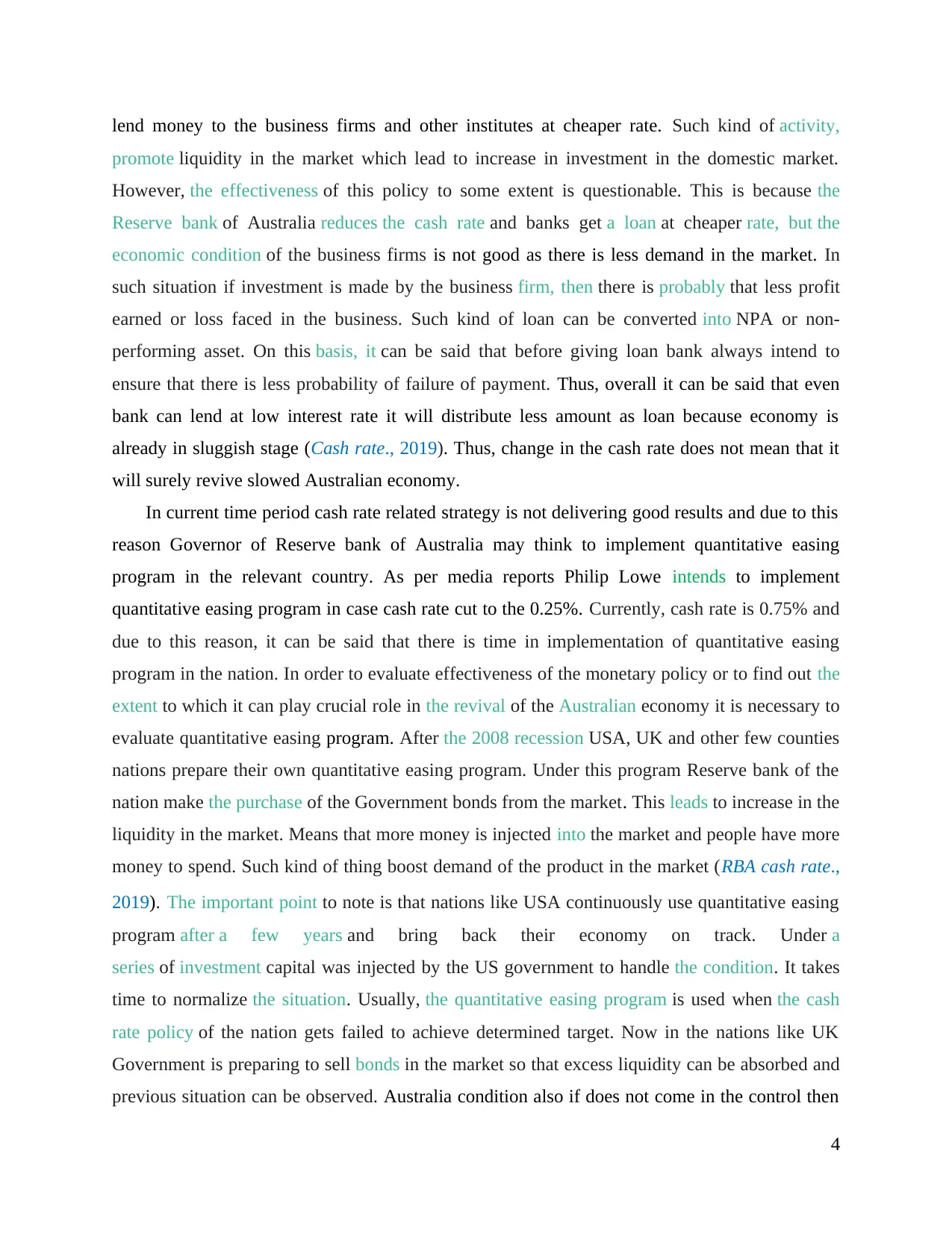
lend money to the business firms and other institutes at cheaper rate. Such kind of activity,
promote liquidity in the market which lead to increase in investment in the domestic market.
However, the effectiveness of this policy to some extent is questionable. This is because the
Reserve bank of Australia reduces the cash rate and banks get a loan at cheaper rate, but the
economic condition of the business firms is not good as there is less demand in the market. In
such situation if investment is made by the business firm, then there is probably that less profit
earned or loss faced in the business. Such kind of loan can be converted into NPA or non-
performing asset. On this basis, it can be said that before giving loan bank always intend to
ensure that there is less probability of failure of payment. Thus, overall it can be said that even
bank can lend at low interest rate it will distribute less amount as loan because economy is
already in sluggish stage (Cash rate., 2019). Thus, change in the cash rate does not mean that it
will surely revive slowed Australian economy.
In current time period cash rate related strategy is not delivering good results and due to this
reason Governor of Reserve bank of Australia may think to implement quantitative easing
program in the relevant country. As per media reports Philip Lowe intends to implement
quantitative easing program in case cash rate cut to the 0.25%. Currently, cash rate is 0.75% and
due to this reason, it can be said that there is time in implementation of quantitative easing
program in the nation. In order to evaluate effectiveness of the monetary policy or to find out the
extent to which it can play crucial role in the revival of the Australian economy it is necessary to
evaluate quantitative easing program. After the 2008 recession USA, UK and other few counties
nations prepare their own quantitative easing program. Under this program Reserve bank of the
nation make the purchase of the Government bonds from the market. This leads to increase in the
liquidity in the market. Means that more money is injected into the market and people have more
money to spend. Such kind of thing boost demand of the product in the market (RBA cash rate.,
2019). The important point to note is that nations like USA continuously use quantitative easing
program after a few years and bring back their economy on track. Under a
series of investment capital was injected by the US government to handle the condition. It takes
time to normalize the situation. Usually, the quantitative easing program is used when the cash
rate policy of the nation gets failed to achieve determined target. Now in the nations like UK
Government is preparing to sell bonds in the market so that excess liquidity can be absorbed and
previous situation can be observed. Australia condition also if does not come in the control then
4
promote liquidity in the market which lead to increase in investment in the domestic market.
However, the effectiveness of this policy to some extent is questionable. This is because the
Reserve bank of Australia reduces the cash rate and banks get a loan at cheaper rate, but the
economic condition of the business firms is not good as there is less demand in the market. In
such situation if investment is made by the business firm, then there is probably that less profit
earned or loss faced in the business. Such kind of loan can be converted into NPA or non-
performing asset. On this basis, it can be said that before giving loan bank always intend to
ensure that there is less probability of failure of payment. Thus, overall it can be said that even
bank can lend at low interest rate it will distribute less amount as loan because economy is
already in sluggish stage (Cash rate., 2019). Thus, change in the cash rate does not mean that it
will surely revive slowed Australian economy.
In current time period cash rate related strategy is not delivering good results and due to this
reason Governor of Reserve bank of Australia may think to implement quantitative easing
program in the relevant country. As per media reports Philip Lowe intends to implement
quantitative easing program in case cash rate cut to the 0.25%. Currently, cash rate is 0.75% and
due to this reason, it can be said that there is time in implementation of quantitative easing
program in the nation. In order to evaluate effectiveness of the monetary policy or to find out the
extent to which it can play crucial role in the revival of the Australian economy it is necessary to
evaluate quantitative easing program. After the 2008 recession USA, UK and other few counties
nations prepare their own quantitative easing program. Under this program Reserve bank of the
nation make the purchase of the Government bonds from the market. This leads to increase in the
liquidity in the market. Means that more money is injected into the market and people have more
money to spend. Such kind of thing boost demand of the product in the market (RBA cash rate.,
2019). The important point to note is that nations like USA continuously use quantitative easing
program after a few years and bring back their economy on track. Under a
series of investment capital was injected by the US government to handle the condition. It takes
time to normalize the situation. Usually, the quantitative easing program is used when the cash
rate policy of the nation gets failed to achieve determined target. Now in the nations like UK
Government is preparing to sell bonds in the market so that excess liquidity can be absorbed and
previous situation can be observed. Australia condition also if does not come in the control then
4
You're viewing a preview
Unlock full access by subscribing today!
Enjoy unlimited downloads | Full document access |
Advanced AI study tools
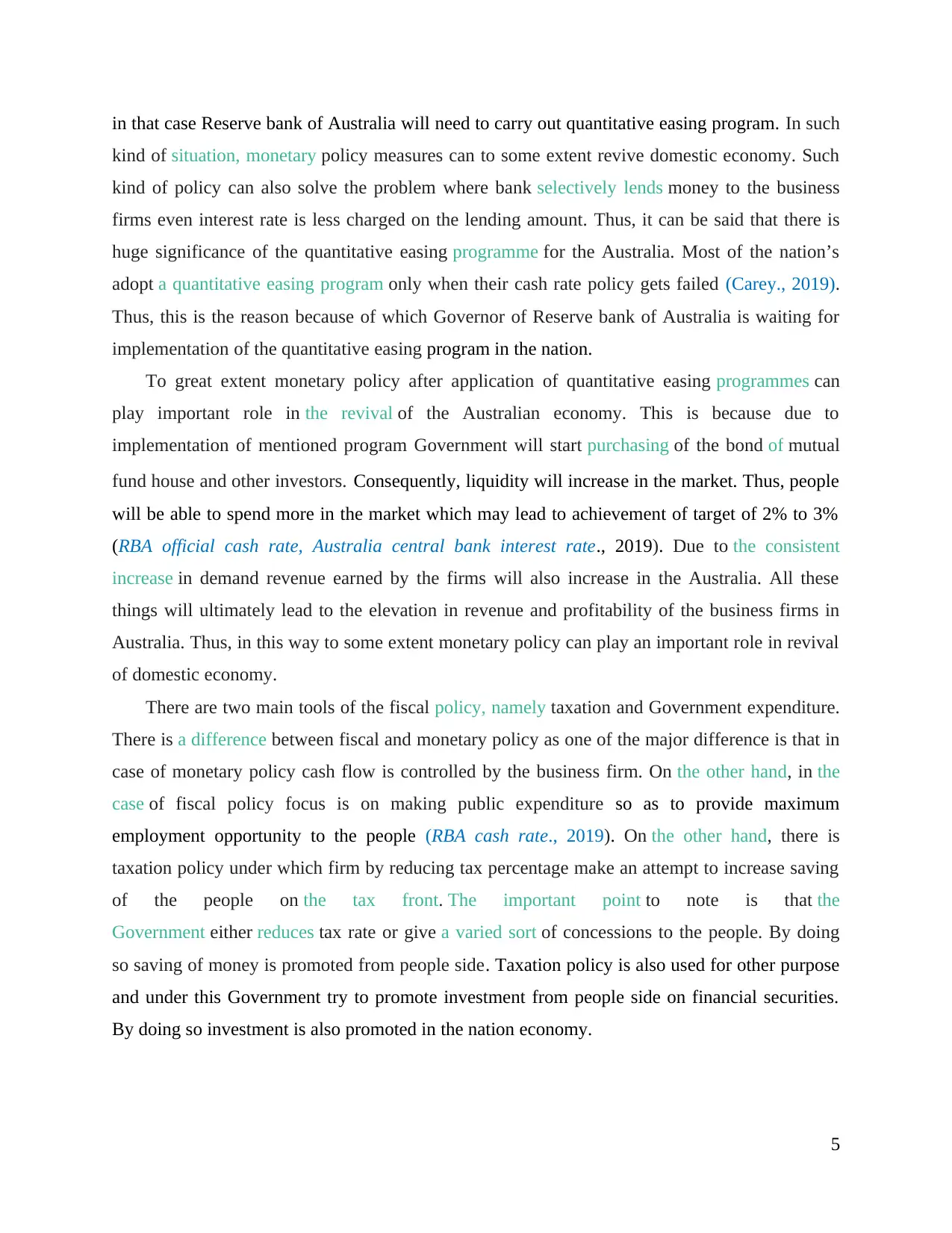
in that case Reserve bank of Australia will need to carry out quantitative easing program. In such
kind of situation, monetary policy measures can to some extent revive domestic economy. Such
kind of policy can also solve the problem where bank selectively lends money to the business
firms even interest rate is less charged on the lending amount. Thus, it can be said that there is
huge significance of the quantitative easing programme for the Australia. Most of the nation’s
adopt a quantitative easing program only when their cash rate policy gets failed (Carey., 2019).
Thus, this is the reason because of which Governor of Reserve bank of Australia is waiting for
implementation of the quantitative easing program in the nation.
To great extent monetary policy after application of quantitative easing programmes can
play important role in the revival of the Australian economy. This is because due to
implementation of mentioned program Government will start purchasing of the bond of mutual
fund house and other investors. Consequently, liquidity will increase in the market. Thus, people
will be able to spend more in the market which may lead to achievement of target of 2% to 3%
(RBA official cash rate, Australia central bank interest rate., 2019). Due to the consistent
increase in demand revenue earned by the firms will also increase in the Australia. All these
things will ultimately lead to the elevation in revenue and profitability of the business firms in
Australia. Thus, in this way to some extent monetary policy can play an important role in revival
of domestic economy.
There are two main tools of the fiscal policy, namely taxation and Government expenditure.
There is a difference between fiscal and monetary policy as one of the major difference is that in
case of monetary policy cash flow is controlled by the business firm. On the other hand, in the
case of fiscal policy focus is on making public expenditure so as to provide maximum
employment opportunity to the people (RBA cash rate., 2019). On the other hand, there is
taxation policy under which firm by reducing tax percentage make an attempt to increase saving
of the people on the tax front. The important point to note is that the
Government either reduces tax rate or give a varied sort of concessions to the people. By doing
so saving of money is promoted from people side. Taxation policy is also used for other purpose
and under this Government try to promote investment from people side on financial securities.
By doing so investment is also promoted in the nation economy.
5
kind of situation, monetary policy measures can to some extent revive domestic economy. Such
kind of policy can also solve the problem where bank selectively lends money to the business
firms even interest rate is less charged on the lending amount. Thus, it can be said that there is
huge significance of the quantitative easing programme for the Australia. Most of the nation’s
adopt a quantitative easing program only when their cash rate policy gets failed (Carey., 2019).
Thus, this is the reason because of which Governor of Reserve bank of Australia is waiting for
implementation of the quantitative easing program in the nation.
To great extent monetary policy after application of quantitative easing programmes can
play important role in the revival of the Australian economy. This is because due to
implementation of mentioned program Government will start purchasing of the bond of mutual
fund house and other investors. Consequently, liquidity will increase in the market. Thus, people
will be able to spend more in the market which may lead to achievement of target of 2% to 3%
(RBA official cash rate, Australia central bank interest rate., 2019). Due to the consistent
increase in demand revenue earned by the firms will also increase in the Australia. All these
things will ultimately lead to the elevation in revenue and profitability of the business firms in
Australia. Thus, in this way to some extent monetary policy can play an important role in revival
of domestic economy.
There are two main tools of the fiscal policy, namely taxation and Government expenditure.
There is a difference between fiscal and monetary policy as one of the major difference is that in
case of monetary policy cash flow is controlled by the business firm. On the other hand, in the
case of fiscal policy focus is on making public expenditure so as to provide maximum
employment opportunity to the people (RBA cash rate., 2019). On the other hand, there is
taxation policy under which firm by reducing tax percentage make an attempt to increase saving
of the people on the tax front. The important point to note is that the
Government either reduces tax rate or give a varied sort of concessions to the people. By doing
so saving of money is promoted from people side. Taxation policy is also used for other purpose
and under this Government try to promote investment from people side on financial securities.
By doing so investment is also promoted in the nation economy.
5
Paraphrase This Document
Need a fresh take? Get an instant paraphrase of this document with our AI Paraphraser
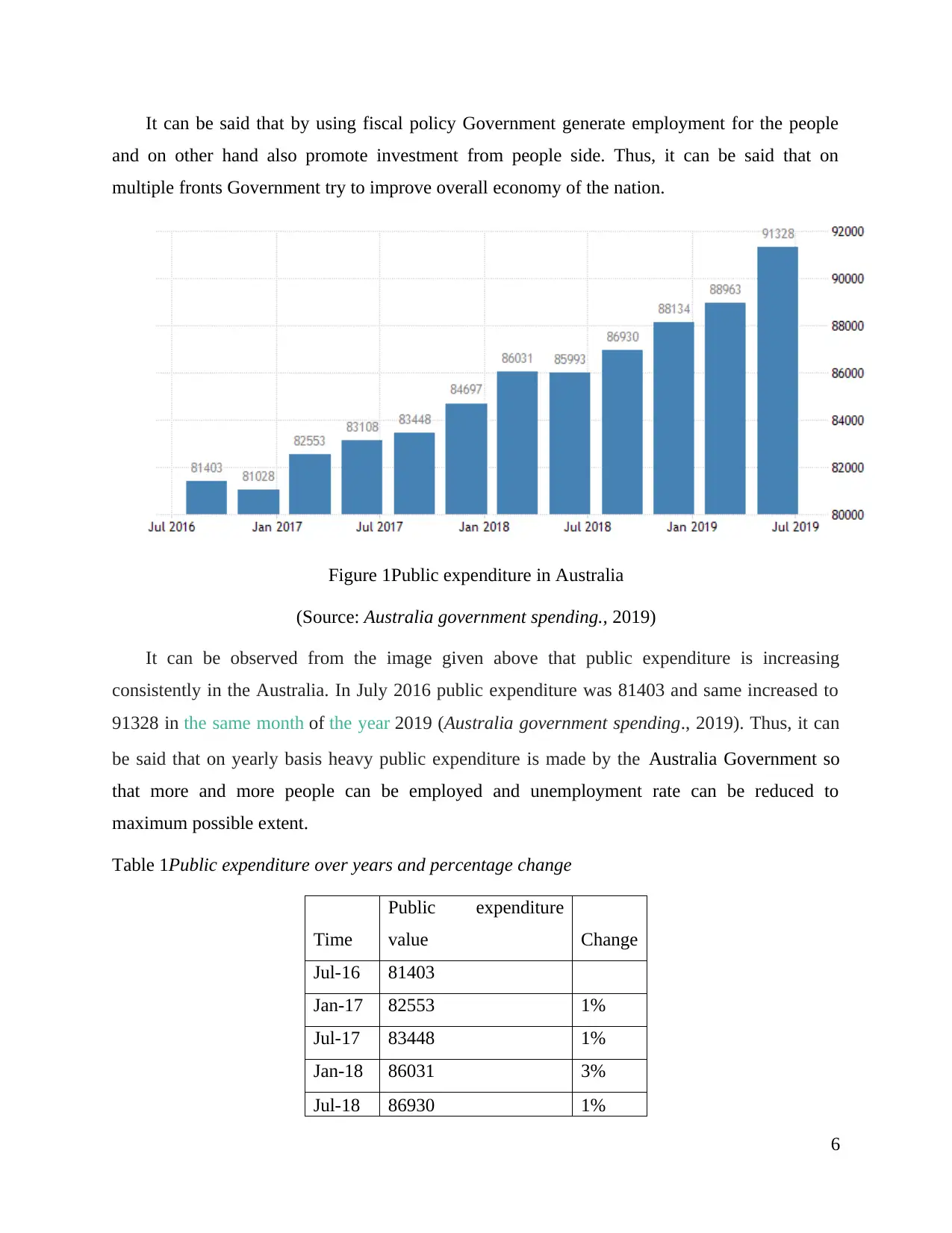
It can be said that by using fiscal policy Government generate employment for the people
and on other hand also promote investment from people side. Thus, it can be said that on
multiple fronts Government try to improve overall economy of the nation.
Figure 1Public expenditure in Australia
(Source: Australia government spending., 2019)
It can be observed from the image given above that public expenditure is increasing
consistently in the Australia. In July 2016 public expenditure was 81403 and same increased to
91328 in the same month of the year 2019 (Australia government spending., 2019). Thus, it can
be said that on yearly basis heavy public expenditure is made by the Australia Government so
that more and more people can be employed and unemployment rate can be reduced to
maximum possible extent.
Table 1Public expenditure over years and percentage change
Time
Public expenditure
value Change
Jul-16 81403
Jan-17 82553 1%
Jul-17 83448 1%
Jan-18 86031 3%
Jul-18 86930 1%
6
and on other hand also promote investment from people side. Thus, it can be said that on
multiple fronts Government try to improve overall economy of the nation.
Figure 1Public expenditure in Australia
(Source: Australia government spending., 2019)
It can be observed from the image given above that public expenditure is increasing
consistently in the Australia. In July 2016 public expenditure was 81403 and same increased to
91328 in the same month of the year 2019 (Australia government spending., 2019). Thus, it can
be said that on yearly basis heavy public expenditure is made by the Australia Government so
that more and more people can be employed and unemployment rate can be reduced to
maximum possible extent.
Table 1Public expenditure over years and percentage change
Time
Public expenditure
value Change
Jul-16 81403
Jan-17 82553 1%
Jul-17 83448 1%
Jan-18 86031 3%
Jul-18 86930 1%
6
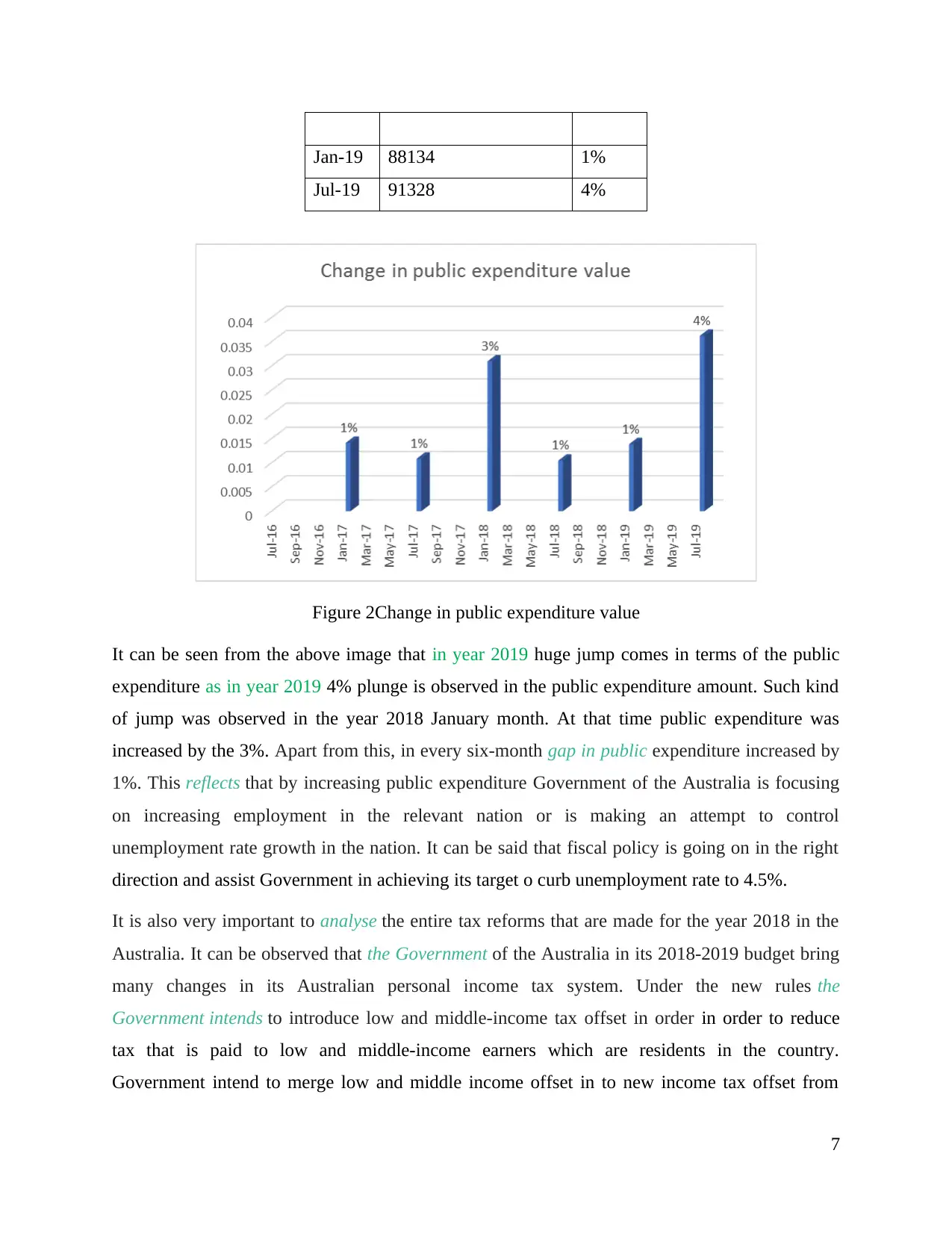
Jan-19 88134 1%
Jul-19 91328 4%
Figure 2Change in public expenditure value
It can be seen from the above image that in year 2019 huge jump comes in terms of the public
expenditure as in year 2019 4% plunge is observed in the public expenditure amount. Such kind
of jump was observed in the year 2018 January month. At that time public expenditure was
increased by the 3%. Apart from this, in every six-month gap in public expenditure increased by
1%. This reflects that by increasing public expenditure Government of the Australia is focusing
on increasing employment in the relevant nation or is making an attempt to control
unemployment rate growth in the nation. It can be said that fiscal policy is going on in the right
direction and assist Government in achieving its target o curb unemployment rate to 4.5%.
It is also very important to analyse the entire tax reforms that are made for the year 2018 in the
Australia. It can be observed that the Government of the Australia in its 2018-2019 budget bring
many changes in its Australian personal income tax system. Under the new rules the
Government intends to introduce low and middle-income tax offset in order in order to reduce
tax that is paid to low and middle-income earners which are residents in the country.
Government intend to merge low and middle income offset in to new income tax offset from
7
Jul-19 91328 4%
Figure 2Change in public expenditure value
It can be seen from the above image that in year 2019 huge jump comes in terms of the public
expenditure as in year 2019 4% plunge is observed in the public expenditure amount. Such kind
of jump was observed in the year 2018 January month. At that time public expenditure was
increased by the 3%. Apart from this, in every six-month gap in public expenditure increased by
1%. This reflects that by increasing public expenditure Government of the Australia is focusing
on increasing employment in the relevant nation or is making an attempt to control
unemployment rate growth in the nation. It can be said that fiscal policy is going on in the right
direction and assist Government in achieving its target o curb unemployment rate to 4.5%.
It is also very important to analyse the entire tax reforms that are made for the year 2018 in the
Australia. It can be observed that the Government of the Australia in its 2018-2019 budget bring
many changes in its Australian personal income tax system. Under the new rules the
Government intends to introduce low and middle-income tax offset in order in order to reduce
tax that is paid to low and middle-income earners which are residents in the country.
Government intend to merge low and middle income offset in to new income tax offset from
7
You're viewing a preview
Unlock full access by subscribing today!
Enjoy unlimited downloads | Full document access |
Advanced AI study tools
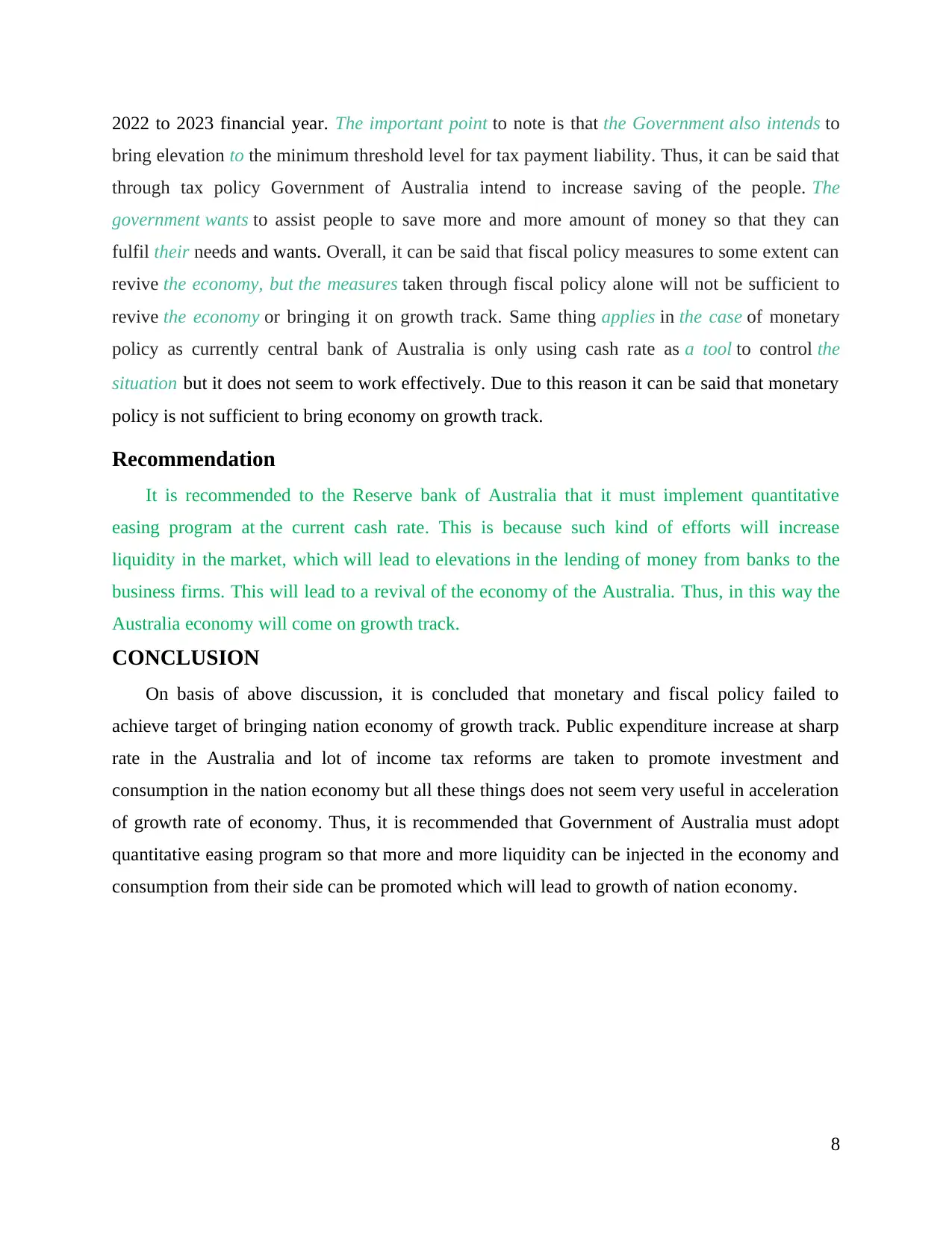
2022 to 2023 financial year. The important point to note is that the Government also intends to
bring elevation to the minimum threshold level for tax payment liability. Thus, it can be said that
through tax policy Government of Australia intend to increase saving of the people. The
government wants to assist people to save more and more amount of money so that they can
fulfil their needs and wants. Overall, it can be said that fiscal policy measures to some extent can
revive the economy, but the measures taken through fiscal policy alone will not be sufficient to
revive the economy or bringing it on growth track. Same thing applies in the case of monetary
policy as currently central bank of Australia is only using cash rate as a tool to control the
situation but it does not seem to work effectively. Due to this reason it can be said that monetary
policy is not sufficient to bring economy on growth track.
Recommendation
It is recommended to the Reserve bank of Australia that it must implement quantitative
easing program at the current cash rate. This is because such kind of efforts will increase
liquidity in the market, which will lead to elevations in the lending of money from banks to the
business firms. This will lead to a revival of the economy of the Australia. Thus, in this way the
Australia economy will come on growth track.
CONCLUSION
On basis of above discussion, it is concluded that monetary and fiscal policy failed to
achieve target of bringing nation economy of growth track. Public expenditure increase at sharp
rate in the Australia and lot of income tax reforms are taken to promote investment and
consumption in the nation economy but all these things does not seem very useful in acceleration
of growth rate of economy. Thus, it is recommended that Government of Australia must adopt
quantitative easing program so that more and more liquidity can be injected in the economy and
consumption from their side can be promoted which will lead to growth of nation economy.
8
bring elevation to the minimum threshold level for tax payment liability. Thus, it can be said that
through tax policy Government of Australia intend to increase saving of the people. The
government wants to assist people to save more and more amount of money so that they can
fulfil their needs and wants. Overall, it can be said that fiscal policy measures to some extent can
revive the economy, but the measures taken through fiscal policy alone will not be sufficient to
revive the economy or bringing it on growth track. Same thing applies in the case of monetary
policy as currently central bank of Australia is only using cash rate as a tool to control the
situation but it does not seem to work effectively. Due to this reason it can be said that monetary
policy is not sufficient to bring economy on growth track.
Recommendation
It is recommended to the Reserve bank of Australia that it must implement quantitative
easing program at the current cash rate. This is because such kind of efforts will increase
liquidity in the market, which will lead to elevations in the lending of money from banks to the
business firms. This will lead to a revival of the economy of the Australia. Thus, in this way the
Australia economy will come on growth track.
CONCLUSION
On basis of above discussion, it is concluded that monetary and fiscal policy failed to
achieve target of bringing nation economy of growth track. Public expenditure increase at sharp
rate in the Australia and lot of income tax reforms are taken to promote investment and
consumption in the nation economy but all these things does not seem very useful in acceleration
of growth rate of economy. Thus, it is recommended that Government of Australia must adopt
quantitative easing program so that more and more liquidity can be injected in the economy and
consumption from their side can be promoted which will lead to growth of nation economy.
8
Paraphrase This Document
Need a fresh take? Get an instant paraphrase of this document with our AI Paraphraser
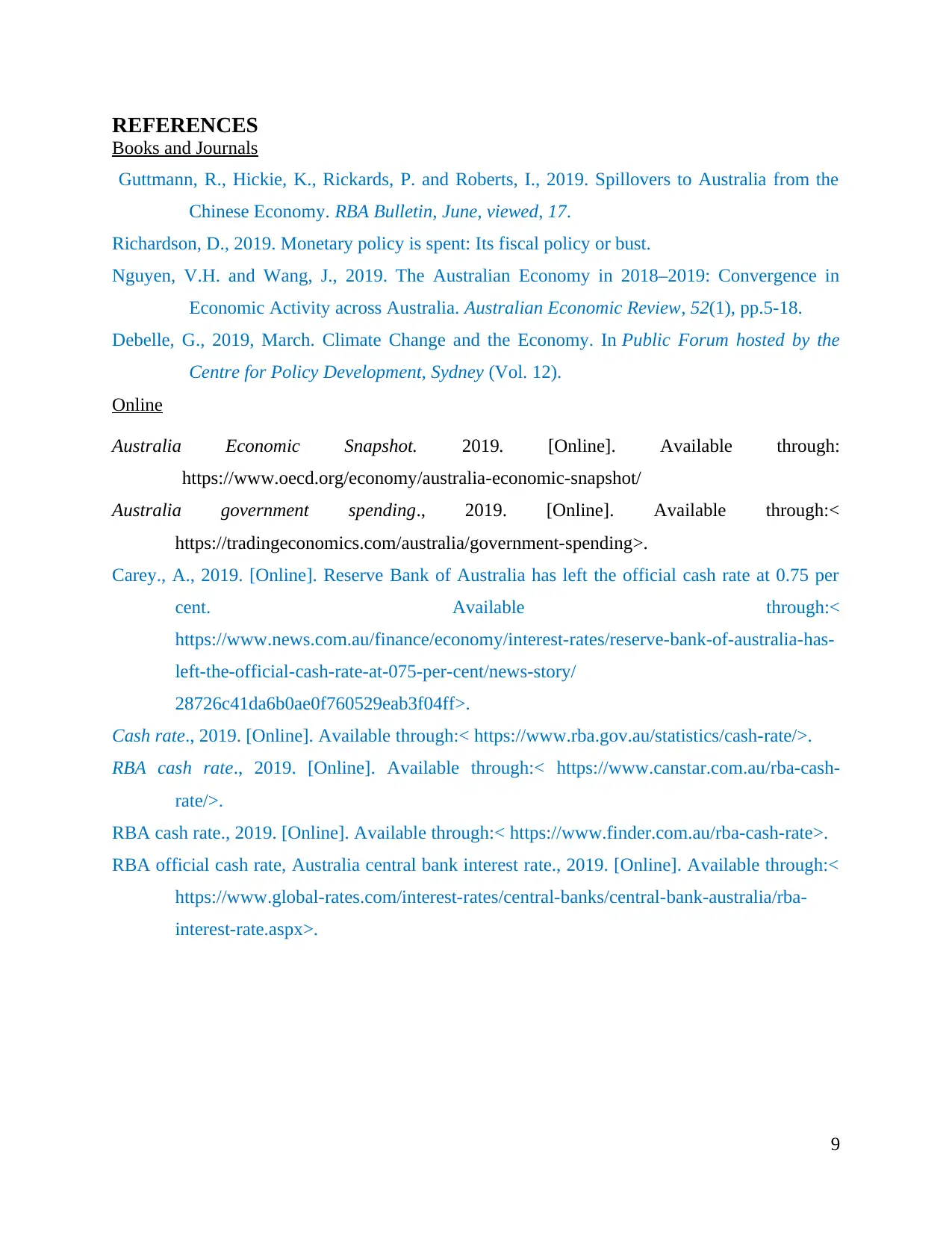
REFERENCES
Books and Journals
Guttmann, R., Hickie, K., Rickards, P. and Roberts, I., 2019. Spillovers to Australia from the
Chinese Economy. RBA Bulletin, June, viewed, 17.
Richardson, D., 2019. Monetary policy is spent: Its fiscal policy or bust.
Nguyen, V.H. and Wang, J., 2019. The Australian Economy in 2018–2019: Convergence in
Economic Activity across Australia. Australian Economic Review, 52(1), pp.5-18.
Debelle, G., 2019, March. Climate Change and the Economy. In Public Forum hosted by the
Centre for Policy Development, Sydney (Vol. 12).
Online
Australia Economic Snapshot. 2019. [Online]. Available through:
https://www.oecd.org/economy/australia-economic-snapshot/
Australia government spending., 2019. [Online]. Available through:<
https://tradingeconomics.com/australia/government-spending>.
Carey., A., 2019. [Online]. Reserve Bank of Australia has left the official cash rate at 0.75 per
cent. Available through:<
https://www.news.com.au/finance/economy/interest-rates/reserve-bank-of-australia-has-
left-the-official-cash-rate-at-075-per-cent/news-story/
28726c41da6b0ae0f760529eab3f04ff>.
Cash rate., 2019. [Online]. Available through:< https://www.rba.gov.au/statistics/cash-rate/>.
RBA cash rate., 2019. [Online]. Available through:< https://www.canstar.com.au/rba-cash-
rate/>.
RBA cash rate., 2019. [Online]. Available through:< https://www.finder.com.au/rba-cash-rate>.
RBA official cash rate, Australia central bank interest rate., 2019. [Online]. Available through:<
https://www.global-rates.com/interest-rates/central-banks/central-bank-australia/rba-
interest-rate.aspx>.
9
Books and Journals
Guttmann, R., Hickie, K., Rickards, P. and Roberts, I., 2019. Spillovers to Australia from the
Chinese Economy. RBA Bulletin, June, viewed, 17.
Richardson, D., 2019. Monetary policy is spent: Its fiscal policy or bust.
Nguyen, V.H. and Wang, J., 2019. The Australian Economy in 2018–2019: Convergence in
Economic Activity across Australia. Australian Economic Review, 52(1), pp.5-18.
Debelle, G., 2019, March. Climate Change and the Economy. In Public Forum hosted by the
Centre for Policy Development, Sydney (Vol. 12).
Online
Australia Economic Snapshot. 2019. [Online]. Available through:
https://www.oecd.org/economy/australia-economic-snapshot/
Australia government spending., 2019. [Online]. Available through:<
https://tradingeconomics.com/australia/government-spending>.
Carey., A., 2019. [Online]. Reserve Bank of Australia has left the official cash rate at 0.75 per
cent. Available through:<
https://www.news.com.au/finance/economy/interest-rates/reserve-bank-of-australia-has-
left-the-official-cash-rate-at-075-per-cent/news-story/
28726c41da6b0ae0f760529eab3f04ff>.
Cash rate., 2019. [Online]. Available through:< https://www.rba.gov.au/statistics/cash-rate/>.
RBA cash rate., 2019. [Online]. Available through:< https://www.canstar.com.au/rba-cash-
rate/>.
RBA cash rate., 2019. [Online]. Available through:< https://www.finder.com.au/rba-cash-rate>.
RBA official cash rate, Australia central bank interest rate., 2019. [Online]. Available through:<
https://www.global-rates.com/interest-rates/central-banks/central-bank-australia/rba-
interest-rate.aspx>.
9
1 out of 11
Related Documents
Your All-in-One AI-Powered Toolkit for Academic Success.
+13062052269
info@desklib.com
Available 24*7 on WhatsApp / Email
![[object Object]](/_next/static/media/star-bottom.7253800d.svg)
Unlock your academic potential
© 2024 | Zucol Services PVT LTD | All rights reserved.





